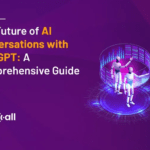
Categories
AI has the capacity to function autonomously and react like a person, speeding up and facilitating laborious processes like sales and advertising and automating repetitive work. AI is also skilled at creating material that has a linguistic structure. What about an AI-powered language model that can interpret lengthy passages, create code and fables, and perform accurate semantic search?
Unquestionably, one of the most potent and ground-breaking artificial intelligence technologies in recent years is the OpenAI GPT-3 API utility. By overcoming linguistic difficulties that were previously thought to be insurmountable for AI systems, the language model that OpenAI presented in 2020 quickly gained notoriety.
The GPT-3 system is gaining acclaim and recognition on a global scale. Its capacity to perform a variety of operations and duties using a pre-established algorithm only adds to its allure. Nevertheless, despite the abundance of astounding GPT-3 instances, we still need to weigh the disadvantages it brings with the benefits it offers.
What is GPT-3?
A language model called the Generative Pre-trained Transformer 3 (GPT-3) employs deep learning methods to create text that mimics human speech. It can also generate computer code, prose, poetry, and other kinds of content in addition to plain text. It has become a hot subject in the natural language processing (NLP) field as a result of these features and capabilities.
In May 2020, OpenAI released GPT-3 to supplant their previous language model (LM), GPT-2. It is asserted to be larger and more durable than GPT-2. The final version of OpenAI GPT-3, with over 175 billion trainable parameters, is the strongest model learned compared to other language models.
See More: Conquer New Horizons With Our AI Development Service
How to access GPT-3 OpenAI?
To use GPT-3 for free, you need a personal email address, a phone number that can get validation notifications, and a location in one of the authorised nations. Go directly to the playground after activating your account, a user interface that enables you to submit questions and provides immediate answers. Mobile devices can also readily access it because the interface is device responsive.
It’s really only two things you’ll need to use: the text field and the publish button. The preset settings are quite good, but some parameters can be changed using the right-hand panels. You must now enter your questions into the textbox and click “Submit.”
It costs for each token whether GPT-3 OpenAI initiates it or not (assuming a token is equivalent to 0.75 words). For the first three months, you are given $18 in free cash that you can use however you like. For $18, you can purchase 300,000 free tokens that can be used to make four full-length books.
How does it work?
GPT-3 is a very sophisticated and intelligent text generator. It creates its best guess as to what the next segment should be after receiving human text input. It then uses the original text it generated and the actual input as a new starting point to make more content, and so on. Its database contains all written materials that are accessible on the internet.
Using information it finds online, the GPT-3 API produces the result it thinks is significantly most likely to back the initial input. Transformers like GPT-3, for instance, comprehend how language works, how words are put together, and what kind of sentence follows immediately after the one that comes before.
A few ideas and models used by GPT-3 include transformers, language models, generative models, semi-supervised learning, zero/one/few-shot learning, multitask learning, and zero/one/few-shot task transference.
Each of these concepts is taken into consideration when creating a GPT model. For instance, the GPT-3 language model performs exceptionally in zero, one, and few-shot multitask environments because it is built on a pre-trained, unsupervised, generative transformer design. This makes it simple to remember that they all operate together to create a GPT-3 model.
Read More: The Difference Between ChatGPT and GPT-3
GPT-3 Use cases
So, let’s talk about some amazing GPT-3 examples and their uses that illustrate its immense potential.
Coding and Bug Detection:
GPT-3 is capable of writing programme code to build websites or apps from the bottom up. It might also fix programming errors. Using GPT-3, problems can be found, resolved, and recorded along with a fix.
Resume Designer:
When it comes to creating an efficient and succinct CV for employment chances, job seekers face significant challenges. GPT-3 can help with resume writing so that they stick out. Simply enter your information, and it will provide terse advice on how to improve your Resume.
Autoplotter
Based on the user’s description, GPT-3 may produce charts and graphs showing ratios or scalability.
Quiz Creator
GPT-3 is an excellent tool for automatically creating quizzes for study on any specific topic, and it can also fully explain the solutions to the questions mentioned in quizzes.
Customer Support
Businesses may use the GPT-3 model to handle frequently asked questions. For instance, GPT-3 can identify the most frequently asked questions and the best responses by studying data from earlier services.
Altering Style of Writing
Ordinary content can be altered by GPT-3 to adopt a new style. Similarly, you may utilize GPT-3 to compose emails, switch between casual and professional tones, or even create articles in a certain structure, such as narrative, descriptive, or persuasive.
Machine Learning Models Creation
Can you envision a scenario where machine learning models begin to create distinct machine learning models independently? It may sound impossible, but GPT-3 can now create ML models tailored to certain applications and datasets.
Tools and Platforms using GPT-3
Let’s explore some well-known platforms utilizing or intending to utilize GPT-3 examples and use cases in their systems to enhance effectiveness.
Spotify:
The business intends to deploy GPT-3 to create personalized playlists catered to each user’s preferences by evaluating the current tracks they are listening to. In addition, based on consumers’ listening patterns and preferences, GPT-3 will also be leveraged to recommend new songs and artists to them.
Grammarly:
To increase the precision and effectiveness of its syntax and spelling checks, Grammarly, a well-known language processing and grammar checker application, has integrated GPT-3 into its platform.
Grammarly uses GPT-3 to more precisely identify and fix grammatical, spelling, and punctuation problems by analyzing the structure and meaning of the text. In addition, it can propose other word choices and phrasings to make content more readable and clearer.
GitHub:
A tool created by GitHub called GitHub Copilot generates natural language descriptions of code using GPT-3. It strives to help developers outline their code succinctly and simply so that it is easier for others to comprehend and reuse the chunks of code.
Read More: Trending Ideas and Use Cases for OpenAI GPT-3
The Darker Side of the GPT-3 Model
Despite the fact that GPT-3 is incredibly big and robust, there are a number of limitations too:
Biased Model:
GPT-3 is prone to bias related to gender, ethnicity, and religion. It can create content that promotes hate speeches hurting the sentiments of individuals.
Misleading Information:
Another issue with GPT-3 is that it can compose news or editorials like humans, raising questions about misleading information.
High-stake Categories:
The technology shouldn’t be utilized in “high-stake categories,” including healthcare, according to a statement from a GPT-3 OpenAI representative. For example, GPT-3 may even generate harmful material based on information found online, a user may ask GPT-3 for advice on how to unwind after a stressful day at work, and GPT-3 would unintentionally suggest dangerous drugs.
Naturally harmful:
Due to the size of GPT-3, putting the model together produces carbon emissions that are roughly equal to “driving a truck to the edge of space.” Large neural networks also need a lot of processing capacity to run, which frequently uses fossil fuels.
Inexpensive for startups:
GPT-3 is too expensive because it requires a lot of computational power for tasks like writing code and creating rich documents. This language model cannot enable small businesses and startups to succeed as a consequence.
enduring memory
Recurrent interactions do not result in fresh information being gathered by GPT-3. The largest text size for this model is approximately four pages, with a context window of 2000 words for each query. GPT-3 won’t remember the context of the earlier queries as a consequence.
Semantics Problems
The sentence is meaningless because GPT-3 does not truly “know” or “understand” the meanings of various words in particular contexts.
Summary-related tasks:
The GPT-3 model has trouble spotting repetitions, inconsistencies, and coherence loss over extended periods of time in text synthesis tasks.
Read More: Potent Technologies in an Unprecedented World: Create an App Using OpenAI
Final Verdict
GPT-3 is noteworthy because it illustrates how AI can be used in the area of natural language processing (NLP). This technology provides a very early look at the use of AI in the future. GPT-3 unquestionably has drawbacks, though, and those must be resolved soon.
GPT-3 API has the potential to greatly improve and optimise a variety of goods and services. However, using it safely is essential, and it is important to take into account the potential negative effects of over-relying on it.
Contact us today to take advantage of our decades of experience creating specialised artificial intelligence solutions.







